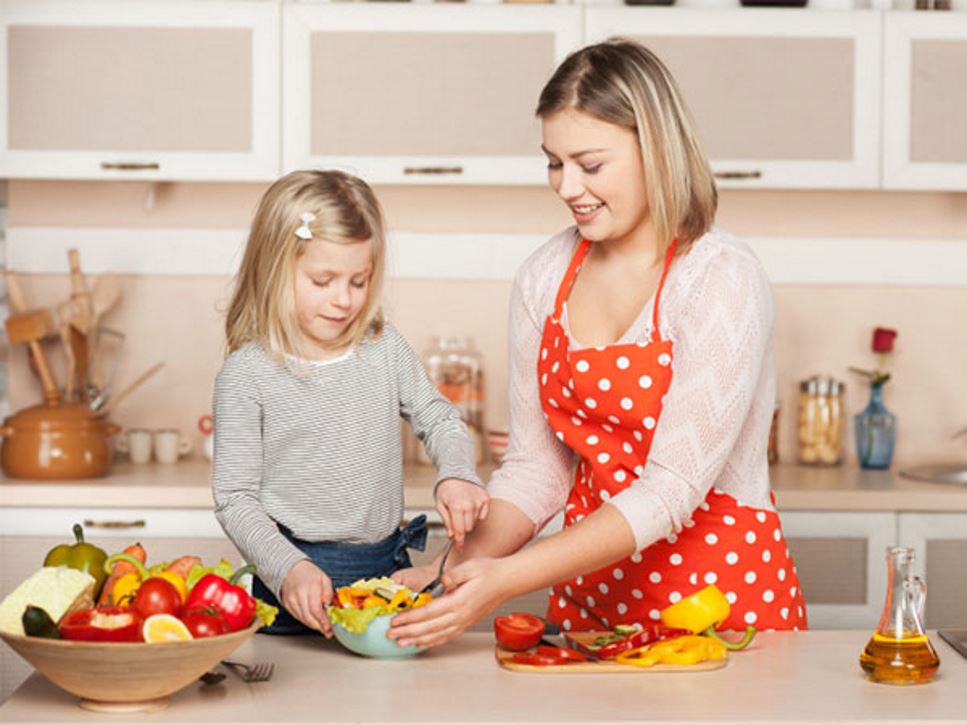The best way to teach kids about eating right is to get them into the kitchen to prepare healthy meals together. Cooking is a valuable life skill that teaches children about nutrition and food safety, as well as building math, science, literacy and fine motor skills.
Encourage your child's interest and excitement in healthy foods by teaching them how to cook safely with this guide of age-appropriate kitchen activities.
Food Safety Basics
Before you enter the kitchen, cover the ground rules with children first:
- Wash hands with warm or cold water and soap before and after handling food.
- Pull back long hair, off the shoulders.
- Keep counter tops and working surfaces clean.
- Teach children to wait until food is cooked before tasting. Don't let them lick their fingers or put their hands in their mouths, especially when working with raw foods such as cookie dough and raw meat or poultry.
- Avoid double dipping or putting spoons back into food after using them for tasting.
- Remember, young cooks need supervision.
- Follow these four simple steps:
- Wash hands, surfaces and kitchen utensils.
- Keep raw meat, poultry and seafood separate from cooked and other ready-to-eat foods.
- Cook food to proper temperatures.
- Refrigerate promptly to 40°F or lower.
Age-Appropriate Kitchen Tasks for Kids
These basics are helpful guidelines for children and adults of all ages. However, it may take more or less time for some children to be able to complete certain tasks.
2- to 3-year-olds
Young children love helping out but need very close adult supervision since their motor skills are still developing. Teach these youngsters the importance of washing produce and using clean appliances and utensils.
Appropriate Tasks:
- Wash hands with warm, soapy water for at least 20 seconds. Make it a game by singing the "Happy Birthday" song together twice as you wash your hands.
- Wash fruits and vegetables in the sink with cool tap water.
- Wipe down tabletops.
- Snap green beans.
- Cut cookies into fun shapes with cookie cutters (but don't eat the raw dough!).
3- to 5-year-olds
Appropriate Tasks:
- Mix ingredients such as pancake or other batters.
- Brush (or "paint") cooking oil on bread, asparagus or other foods with a clean pastry or basting brush.
- Break eggs into a bowl and wash hands afterwards.
- Mash potatoes.
5- to 7-year-olds
Most 5- to 7-year-olds have developed fine motor skills, so they can handle more detailed work, but they will still need food safety reminders.
Appropriate Tasks:
- Scoop out avocados after sliced in half by an adult.
- Load the dishwasher.
- Shuck corn and rinse before cooking.
- Rinse and cut parsley or green onions with clean, blunt kitchen shears.
7- to 9-year-olds
There is a wide range of skills in this age group, so tailor your tasks to each child's maturity level. Teach the importance of wiping down all surfaces and refrigerating perishables, such as eggs and milk, right away.
Appropriate Tasks:- Open cans with a can opener.
- Put leftovers in shallow containers and refrigerate within two hours (one hour if it’s warmer than 90 degrees Fahrenheit).
- Pound chicken on a cutting board. Note: Always use a separate cutting board for ready-to-eat and raw foods, and be sure to wash hands with warm, soapy water after handling raw meats and chicken.
- Beat eggs.
- Check the temperature of meat with a food thermometer — it's like a science experiment!
- Use a peeler to peel raw potatoes, ginger, mangoes and other washed fruits and vegetables.
9- to 12-year-olds
For the most part, kids ages 9 to 12 can work independently in the kitchen, but should still have adult supervision. Before letting these kids do grown-up tasks on their own, assess whether they can follow basic kitchen rules such as adjusting pan handles over counters to avoid bumping into them, unplugging electrical appliances, using knives and safely using the oven or microwave.
Appropriate Tasks (with adult supervision):
- Boil pasta.
- Microwave foods.
- Follow a recipe, including reading each step in order and measuring ingredients accurately.
- Bake foods in the oven.
- Simmer ingredients on the stove.
- Slice or chop vegetables.
Cooking together can be a fun way to teach your child valuable skills, promote good nutrition and make long-lasting memories in the process.
References
Find a Nutrition Expert
Looking for credible nutrition information and recommendations? The Academy of Nutrition and Dietetics' network of credentialed food and nutrition practitioners are ready to help!

